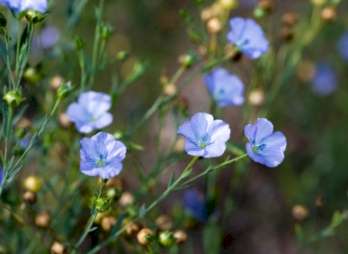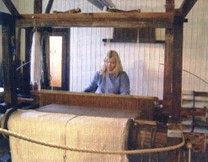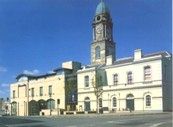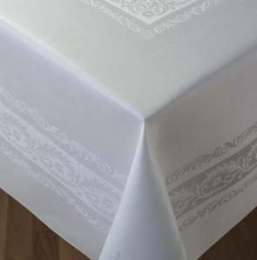Irish linen
The history of Irish linen
-
Home
›
-
Irish crafts
›
-
Irish Linen
The cultivated flax plant 'Linum usitatissimum'
 |
Although the history of Irish linen is fairly well documented, the name of the bright spark who discovered the process of creating it is not known.
Perhaps that's just as well because whoever he or she was would quickly be labelled as very, very weird!
After all, what kind of mind imagines that a lustrous cloth can be created by rotting the stem of the blue-flowered flax plant, beating it with a wooden mallet and,
after hours of spinning into yarn and weaving into cloth, boiling it in fermented bran before rinsing it buttermilk. It sounds more like a recipe for a putrid slop.
Certainly there are some extremely smelly stages in the process but the earliest experimentors must have held their noses long enough to discover that this bizarre method produced a strong, if originally rather coarse, fabric.
After such an unpromising start it is surprising that this cloth -- carefully removed of its malodourous qualities -- developed into one of Ireland's best known and most respected brands: Irish Linen.
Today, the industry has an annual turnover of approximately £150 million and produces about 40 million metres a year of quality cloth.
About 85% of this is exported, mostly to the USA, Britain, France and Italy, while the remainder is snapped up not just by locals but by visitors keen to take home a quality souvenir.
From Egypt to Lisburn
The reputation of linen belies its humble origins as a rather unexceptional annual plant. Its history, however, is somewhat less prosaic.
It was probably the Egyptians who first recognised linen as a quality fabric and their early production methods can be seen on ancient hieroglypics.
The cloth was used by the Pharoahs and other nobles as a statement of high status and, after their death, about 1000metres of linen was used in the mummifying process.
A piece of Egyptian linen cloth from the tomb of King Tutankhmun is on display at the excellent Flax to Fabric exhibition at the Irish Linen Centre in Lisburn, Northern Ireland.
This exhibition should be top of the itinerary for anyone exploring the lives of ancestors who grafted long and uncomfortable hours to produce Irish linen.
It not only brings alive the sometimes grim history of the fabric since it arrived with the Celts in the first millennium BC, it also explains how it is made and offers plenty of demonstrations and hands-on experience of spinning and weaving.
See box below for further details.
The arrival of the spinning wheel
Ireland really picked up the thread of the linen story in early Christian times (St Patrick is said to be buried in a shroud of Irish linen)
but although production continued through the Middle Ages, it was not until the 17th century that a structured industry started to develop.
 Two of the most important influences in this development were the adoption of the Dutch spinning wheel (which became known as the low Irish wheel) and the Dutch loom which was wider than those to which Irish weavers were accustomed.
Two of the most important influences in this development were the adoption of the Dutch spinning wheel (which became known as the low Irish wheel) and the Dutch loom which was wider than those to which Irish weavers were accustomed.
When the French Huguenots arrived a few years later, they added their expert textile skills to the already well-established industry and by the start of the 18th century they controlled linen production.
By this time, the industry had become concentrated in the region between the River Lagan and River Bann.
As the fame and reputation of Irish linen flourished, this area of Ulster, which is now in Northern Ireland, became known as the Linen Homelands.
However, this does not mean that raw materials for the fabric were grown only in the North.
As proved by the Spinning Wheel Entitlement List of 1796 (an essential resource for Irish family history research incorporating the names and parishes of nearly 60,000 farmers), some 36% of all flax growers in Ireland were spread across the rest of the island.
The end of the cottage industry
With the invention of the mechanical cotton spinning machine in the last quarter of the 18th century, linen lost much trade to its competitor.
It was not until the 1820s that a wet spinning machine, suitable for flax yarn, was developed and shortly afterwards the first steam-powered flax spinning mill was built in Belfast.
The fortunes of linen producers revived and by 1871 there were 78 flax spinning mills with a workforce of 43,000.

The days of the cottage industry, with the women and younger children spinning yarn while the men and older sons worked on their looms in the home, were over.
Most of our linen worker ancestors now lived within walking distance of their workplace, often in houses built by the mill and factory owners.
The names of roads in many Irish towns often hark back to these days: Linen Hall Street, Weavers Row, Mill Street.
Even after industrialisation, linen continued to give work to many country people.
Farm workers processed flax to supply the mills while many women worked at home sewing household textiles and clothing.
By 1915, some 75,000 people were working in the industry and the Linen Homelands had become the world's largest linen-producing region.
Modern production

The Irish Linen Centre & Lisburn Museum,
Market Square, Lisburn, co. Antrim, BT28 1AG, Northern Ireland.
Telephone: +44 (0)28 9266 3377.
Open: Mon-Sat, 9.30am to 5pm.
The Irish Linen Centre is dedicated to the study and interpretation of the history of the Irish linen industry.
It does not have any genealogical resources to help you find your ancestors.
However, if you believe your ancestors may have worked in the industry, the centre and its exhibition will provide you with an indepth understanding of their lives.
Since then, the industry has changed dramatically. Factories now bear little similarity (thank goodness) to the original mills.
Heavy investment in technology in computer-aided design and modern looms means manufacture is less labour intensive than it used to be and much, much quicker.
This can be seen on a tour of Ferguson's of Banbridge in co. Down, one of the oldest names in Irish Linen and famed for being the only company in the world to produce double damask.
Computerised looms are watched over by experienced weavers and, while the machines are still noisy, the atmosphere is bright and clean.
In just six days these looms can produce a length of fabric which would previously have taken six months.

Fine scroll double damask from Fergusons
After weaving, the linen is sent away for specialist treatment to produce the unique texture, drape and lustre of a damask tablecloth or the cool comfort of linen sheets.
When returned to the factory the cloth is cut by hand, hemmed by expert seamstresses, ironed and beautifully packaged.
Each process can be watched close up at the factory. Fascinating!
Although the company produces hankies, gifts and some bathroom accessories, Ferguson's of Banbridge remains faithful to bed and table linen.
Competition since the 1950s and 1960s from man-made fibres, paper (for hankies and napkins) and cheap cotton from Asia has seen many other manufacturers in Northern Ireland shift to man-made cloth production or the linen clothes market.
The emergence of a fashion for linen clothing has given the industry a new lease of life.
International designers love working in Irish Linen fabric, partly because of its natural, breathable qualities but also because modern finishing techniques can reduce its creased appearance.
It never really made its mark in traditional Irish clothing, except for a few items of dress for better-off folk, but it is fully accepted as a contemporary fabric.
Not surprisingly, it is always a highlight of Belfast's annual Fashion Week when Irish linen clothing appears in the collections of famous international designers.
The industry that started so humbly in the Irish countryside has gone on to supply the top boutiques of New York, Paris, Milan and London.




 Two of the most important influences in this development were the adoption of the Dutch spinning wheel (which became known as the low Irish wheel) and the Dutch loom which was wider than those to which Irish weavers were accustomed.
Two of the most important influences in this development were the adoption of the Dutch spinning wheel (which became known as the low Irish wheel) and the Dutch loom which was wider than those to which Irish weavers were accustomed.


